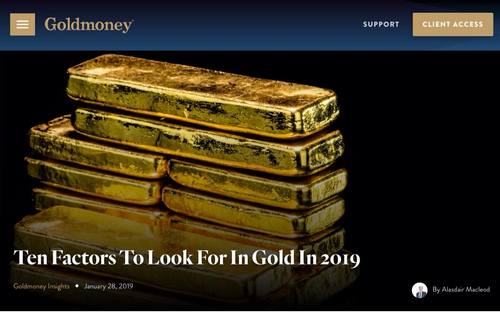แยกเป็นสองหัวข้อคือ จากผลของพัฒนาการทางเศรษฐกิจ และผลกระทบต่อทองคำโดยตรง Possible economic developments to look for ..ขณะนี้อยู่ในช่วงสุดท้ายของวงจรเครดิต ซึ่งดูเหมือนจะไม่มีขั้นตอนการขยายตัวได้อีกแล้ว
..การขาดดุลของรัฐบาลยังคงเพิ่มขึ้นต่อเนื่อง จากรายรับที่ลดลงและรายจ่ายสวัสดิการที่เพิ่มขึ้น แน่นอนว่าอัตราเงินเฟ้อก็จะต้องสูงขึ้นอย่างที่เราเริ่มเห็นกันแล้ว
..การค้าระหว่างประเทศเริ่มลดลงอย่างรวดเร็ว ดังที่เห็นได้จากดีมานด์ของจีนที่กำลังลดลง ..การขึ้นภาษีของสหรัฐจะเป็นตัวเร่งผลกระทบที่ร้ายแรงของการค้าระหว่างประเทศ
..การขาดดุลงบประมาณของสหรัฐจะเพิ่มมากขึ้นพร้อมๆกับการขาดดุลการค้าของประเทศ ...เห็นได้จากการใช้เครดิตจากแบ้งค์ไม่ได้ลดลงเลย ...พูดให้ชัดอีกอย่างคือ การค้าระหว่างประเทศที่ลดลงจะเป็นต้นเหตุใหญ่ของเศรษฐกิจในประเทศที่ตกต่ำลง ..หนีไม่พ้นที่ Fed อาจต้อง finance รัฐบาลสหรัฐโดยการทำ QE อีก
..เศรษฐกิจของประเทศในเอเซีย ..จีน..รัสเซีย..อินเดีย..อิหร่าน ต่างก็หันหลังให้กับดอลล่าร์ในการใช้ชำระหนี้ เรื่องนี้จะมีผลอย่างมากต่อเงินรีเสิร์ฟของธนาคารกลางที่ไม่ใช่แค่ของประเทศในเอเซีย แต่ทั่วไปหมดที่จะเทดอลล่าร์ออกมา หลายๆประเทศเช่นรัสเซีย ก็ทดแทนโดยการนำเข้าทองคำ
..ทรัพย์สินที่เป็นดอลล่าร์..รวมถึงเงินดอลล่าร์ที่ต่างประเทศถือรวมกันสูงถึง $22.6 ล้านล้าน ซึ่งมากกว่า GDP สหรัฐในอัตราที่สูงที่สุดที่เคยเห็นกันมา ถ้าตลาดหลักทรัพย์ทั้งหุ้นทั้งพันธบัตรในสหรัฐจะต้องมีการร่วงจากค่าของดอลล่าร์เมื่อไหร่ แน่นอนว่าจะต้องมีการเทขายทรัพย์สินดอลล่าร์และเงินดอลล่าร์กันขนานใหญ่แน่
Factors directly affecting gold
..ภูมิรัฐศาสตร์ ทั้งรัสเซียและเอเซียต่างพากันเปลี่ยนเงินดอลล่าร์รีเสิร์ฟเป็นทองคำกันแล้ว ..ถ้ารัสเซียเป็นผู้ส่งออกน้ำมันที่ใหญ่ที่สุดของโลก แล้วยังคงใช้ดอลล่าร์ที่ได้ไปแลกเป็นทองคำอยู่อย่างนี้ อีกทั้งยุโรปกลางเช่นฮังการีและโปแลนด์ก็ยังสะสมทองคำเป็นรีเสิร์ฟไม่หยุด ..คงไม่ต้องบอกว่าลมจากเอเซียจะพัดไปทางไหน ..ชาวเอเซียส่วนใหญ่รู้ดีว่า..ทองคำนี่แหละเป็นจุดอ่อนของอเมริกัน
..เงินเฟ้อจากราคาสินค้ามีการตีความกันผิดๆ ในแบบที่ตัวเลขยกเมฆ CPI ยกมาอ้างว่า มันสูงขึ้นมาแค่ 8% ตั้งแต่ตอนที่ราคาทองคำพุ่งสูงลิ่วเมื่อกันยายน 2011 ...แต่ความจริง ดอลล่าร์สูญเสียอำนาจซื้อไปถึง 43% ตั้งแต่นั้น ...ดังนั้นถ้าเอามูลค่าดอลล่าร์ ณ ปี 2011 มาคำนวนราคาทองคำวันนี้ จะเท่ากับ $740/ออนซ์ ...แปลกที่ไม่มีใครสังเกตุเลยว่าปัจจุบันทองคำราคาถูกแค่ไหน
..เงินเฟ้อจากปริมาณเงิน (monetary inflation) ที่เกิดหลังจากวิกฤติ Lehman ไม่ได้เกิดเต็มตัวซะทีเดียว ....ปริมาณเงิน (FMQ) สูงขึ้น $5 ล้านล้านจากก่อนวิกฤติ ..Fed ก็ยังไม่สามารถนำมันกลับคืนไปได้ ..ตรงกันข้าม มีทีท่าว่าอาจจะต้องเพิ่มปริมาณเงินเฟียตขึ้นอีก มาให้รัฐบาลยืมไปจ่ายดอกเบี้ยถ้าเศรษฐกิจมีอันต้องถดถอยลง
..เงื่อนไขทั้งหมดที่กำลังเผชิญกันอยู่เวลานี้ มันเหมือนรัฐบาลเยอรมันเผชิญเมื่อปี 1918 และ 1923 ..การแก้ปัญหาของ Fed ก็คงใช้วิธีเดียวกัน ..พิมพ์เงินออกมาหนุนการขาดดุลของรัฐบาล ผลของมันคือ ความมั่งคั่งทั้งหมดของเศรษฐกิจการผลิตที่ดี กลายเป็นการพังทลายจากการใช้จ่ายแบบลืมตัวของรัฐบาล ..สิ่งที่ต่างกับเยอรมันคือ สหรัฐยังมีระบบภาษีที่แข็งแกร่งกว่าเยอรมันยุคนั้น ..แต่ถึงกระนั้น ปัญหาค่าเงินสหรัฐเหมือนยืนอยู่ปากเหว ..แม้แต่จะบอกกับสาธารณชนเกี่ยวกับเรื่องเงินเฟ้อยังยากเลย
..เรื่องสำคัญเลย ทองคำไม่ใช่สิ่งที่ประชาชนพากันสะสมเลยในโลกตะวันตก
*************
GoldMoney Insights
Ten Factors To Look For In Gold In 2019
January 28, 2019. By Alasdair Macleod
The following is a list of the ten most important factors likely to affect gold in 2019. I have grouped them under two broad headings, economic developments, and factors affecting gold itself.
Possible economic developments to look for
It’s late in the credit cycle, and it appears the end of the expansion phase is in sight. This being the case, we can see that government deficits are going to increase, due to lower tax receipts and higher welfare commitments as economic activity contracts. This will be covered by an increase in the rate of monetary inflation, which we are already seeing.
International trade flows have slowed sharply, as can be seen from China’s slump in demand. There can be no doubt that US tariff policies are having what could turn out to be a catastrophic effect on international trade.
Besides the decline in global trade being a clear signal that the global economy is in trouble, the budget deficit in the US will rise and therefore the trade deficit will tend to rise as well. If not, an increase in the savings rate must occur, which I think we can rule out, or there has to be a contraction in bank credit. In other words, contracting international trade can be expected to propel the US and other domestic economies into a slump. This is bound to provoke the Fed into financing the US government deficit through yet more QE.
The main economies in Asia (China, Russia, India and Iran) are all turning their backs on the dollar for trade settlement. This will have a profound effect on central bank reserves not just in Asia, but elsewhere as well, with the dollar being sold. Some countries, notably Russia, are buying gold instead.
Foreign ownership of dollar assets and cash exceeds US GDP: $18.412 plus $4.22bn equals $22.6tn. This is the highest rate relative to GDP ever seen. When the dollar and US securities markets begin to fall in earnest measured in declining dollars, there is bound to be massive foreign selling of dollars and dollar assets.
Factors directly affecting gold
Geopolitics – Asia, and Russia publicly, have swapped reserve dollars for gold. Given Russia is the world’s largest energy exporter, she will continue to have dollars to sell for gold. Also, Central Europeans, notably Hungary and Poland, are accumulating gold reserves. It is clear which way the Asian wind is blowing, and the Asians know gold is America’s weak point.
Price inflation has been badly misrepresented by CPI figures and have been averaging closer to about 8% annually since gold topped in Sept 2011. Since then the purchasing power of the dollar has declined by about 43%, so that in 2011 dollars the gold price is $740. No one seems to have noticed, leaving gold extremely cheap.
Monetary inflation post-Lehman crisis has not been fully absorbed. FMQ is still over $5tn above the pre-Lehman long-term expansion trend, and the Fed is unable to bring it down. Rather, they are likely to increase the fiat money quantity to save the government from having to borrow at market rates as the recession bites.
These are exactly the conditions faced by the German government between 1918 and 1923, and the likely response by the Fed will be the same. Print money to fund government deficits. Result, wealth transferred from the productive economy to be destroyed in government spending. The only difference is US and other welfare states have a stronger tax base than post-war Germany, so the rate of monetary expansion relative to the size of the economy will be less. Nevertheless, we are on the slippery slope to currency destruction and it will take much more political courage to address the inflation issue than the current political class appear to be capable of.
Gold is massively under-owned in the west.
The views and opinions expressed in this article are those of the author(s) and do not reflect those of Goldmoney, unless expressly stated. The article is for general information purposes only and does not constitute either Goldmoney or the author(s) providing you with legal, financial, tax, investment, or accounting advice. You should not act or rely on any information contained in the article without first seeking independent professional advice. Care has been taken to ensure that the information in the article is reliable; however, Goldmoney does not represent that it is accurate, complete, up-to-date and/or to be taken as an indication of future results and it should not be relied upon as such. Goldmoney will not be held responsible for any claim, loss, damage, or inconvenience caused as a result of any information or opinion contained in this article and any action taken as a result of the opinions and information contained in this article is at your own risk.
Cr.Sayan Rujiramora
สนับสนุนข่าวโดย ICMarkets
เพิ่มเพื่อนรับข่าวสารตลาดหุ้น Forex และบทความดีๆ ด้านการเงิน การลงทุน ฟรี!!
http://line.me/ti/p/%40zhq5011b
Line ID:@fxhanuman
FB:https://www.facebook.com/review.forex.broker/


